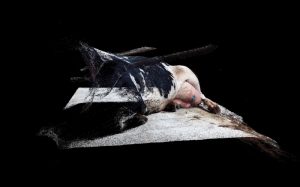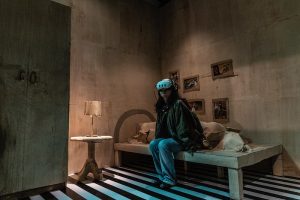Some choose to embrace art from China, others believe that we should boycott their art as much as the political context. If you follow this blog you’ll know on which side i stand, i can’t get enough of the China art scene. All my China art-mania didn’t save me from being castigated: my blog has been banned in China (euh? what happened here? too much pornography?)
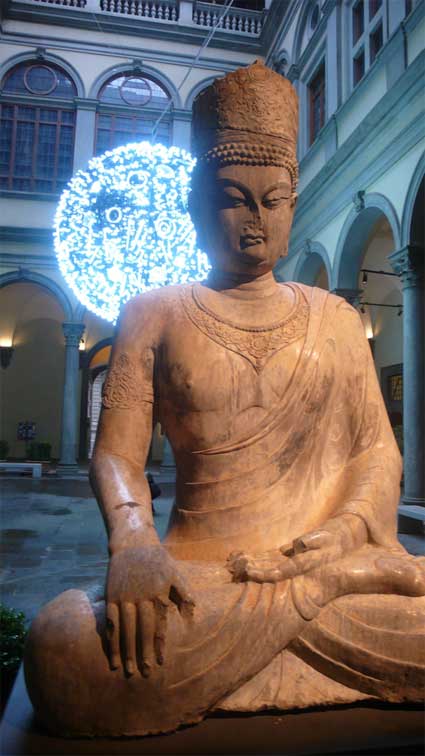 Courtyard of Palazzo Strozzi, Florence
Courtyard of Palazzo Strozzi, Florence
Unrepentant and un-vindicated, i paid a second visit to Florence this year, to check out China China China !!! at the recently opened Centro di Cultura Contemporanea Strozzina (CCCS). The title of the exhibition reflects quite well the plethora of contemporary Chinese art exhibitions which have been sweeping Europe over the past few years.
I recently complained that i keep seeing works by the same elite of artists again and again at every exhibition about Chinese art i happen to visit. Maybe that’s one of the many reasons that explain why i like it so much. It’s a kind of McDonald’s effect, i know before i enter what i’m going to find inside: laughing men, a spat of blood here and there and oh! look! Mao has grown tits!
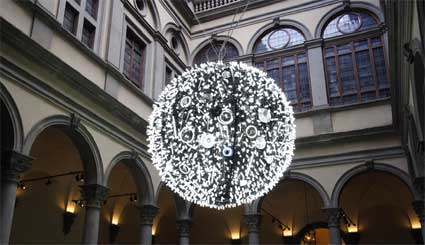 Artificial Moon, Wang Yu Yang, first seen in Beijng last Summer
Artificial Moon, Wang Yu Yang, first seen in Beijng last Summer
However, the Florence exhibition is different on several levels. The first reason jumps at you as you enter one of the first rooms of the exhibitions and discover a series of videos and texts. Each of them document how several exhibitions have recently felt the wrath of the very elastic rules that guide censorship in China. They had to close because some works contained nudity or were judged too “unstable”.
Not only does China China China!!! offer a clear vision of the difficult situation that curators, gallerists and artists alike have to deal with, it also takes up the challenge to give visitors a glimpse of the way Chinese artists echo the complex reality of a country facing an historical change and cultural transformation. To ensure a balanced and somewhat independent view on the “China phenomenon”, the CCCS invited three “insiders”, all of whom live and work in China, are not associated with government institutions, and have worked independently for years. Each of them has a very different but complementary and always critical perception of China’s art scene and its mechanism. The result is nothing like the Chinese art you’ve been seeing around Europe and the USA over the past few years.
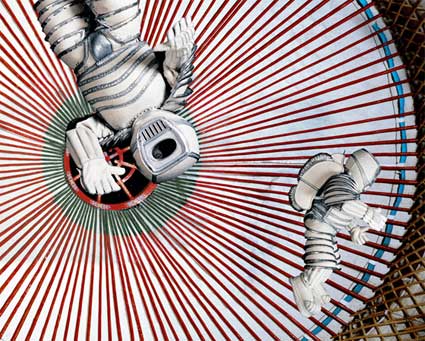 Wu Ershan, Nomadic Plan in Outer Space
Wu Ershan, Nomadic Plan in Outer Space
Beijing-based artist, curator and founder of the independent Art Lab Li Zhenhua curated the section that i found the closest to my own interests. His approach focuses on common cultural roots between different populations, both between China and its neighbours and, at the more macroscopic level, between East and West.
His contribution in the exhibition revolved around the figure of Genghis Khan, founder of the Mongol Empire, the largest contiguous empire in history. He came to power by uniting many of the nomadic tribes of northeast Asia. After founding the Mongol Empire, he set himself the goal to invade and conquer East and Central Asia. During his life (c. 1162-1227), the Mongol Empire eventually occupied most of Asia.
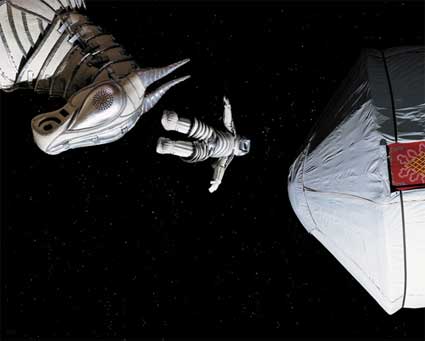 Wu Ershan, Nomadic Plan in Outer Space
Wu Ershan, Nomadic Plan in Outer Space
Li Zhenhua chose to invoke his figure as a symbol of the pioneering spirit and communication between civilizations. However, the focus goes beyond the historical past and leads to an analysis of the roots of possible visions of the future of humanity. His section, entitled “Multi-Archaeology”, explores cultural identity, the way individuals are shaped by constant change and reciprocal cultural influences, and thereby the relative value of concepts such as “nation” or “race”.
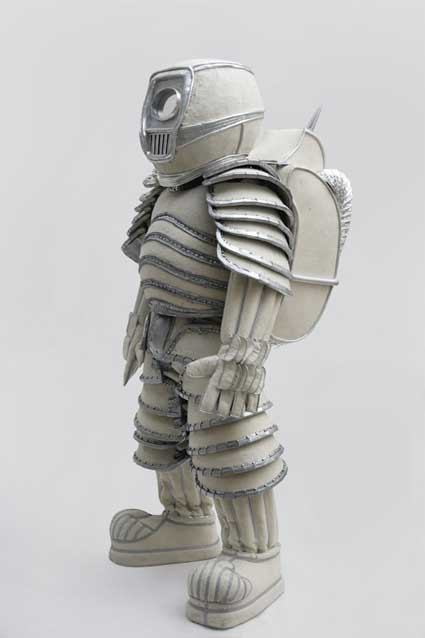 Wu Ershan, Nomadic Clothes / Space Suit
Wu Ershan, Nomadic Clothes / Space Suit
His selection includes Nomadic Plan in Outer Space is a body of work by Mongolian artist Wu Ershan that comprise, sculptures, installations and photographs along with the costume and photos from the film which represent Mongolians’ nomadic life in the universe. They allude to a non-linear story where the past, the present and the future merge.
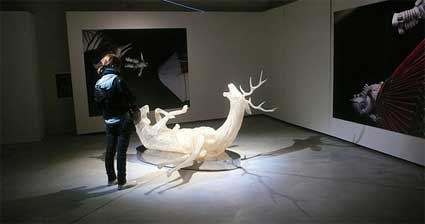 Wu Ershan, The first infant who cried aloud is Tiemuzhen, 2008
Wu Ershan, The first infant who cried aloud is Tiemuzhen, 2008
The art video by Zhao Liang and Shen Shaomin documents the situation on the Chinese border with North Korea and Russia. An analysis of the consequences of the Mongolian invasion by Genghis Khan on Asiatic culture is compared to the impact of modern globalization, in the constant cultural interchange between East and West. In the same time, the works highlight that the Chinese are not the homogeneous, mono-faceted people we often refer to.
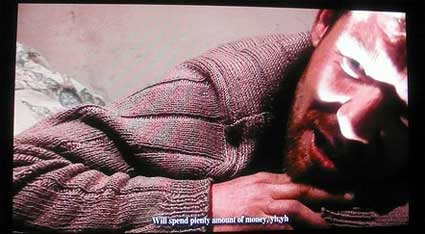
Shen Shaomin’s subject is particularly melancholic and poignant. His video, called I am Chinese, takes place in Hongjiang, a village on the border with Russia. During the First World War, when Germany invaded Russia, some Russians on the Chinese border were forced across the Heilongjiang River to Hongjiang Village. Other immigrants joined during WW2 and the October Revolution but the whole Russian community was still struggling to integrate with Chinese society. Things turned really sour during the Chinese Cultural Revolution (1966-1976) as some of the Russians in the village were suspected of being spies and the village got nicknamed “the village of spies”. In order to be finally accepted by the Chinese, the elders in the Russian community suggested that marriage should be allowed only to pure Chinese in order to mask the Russian origin of their offspring. This of course resulted in genetic modifications and the birth of a mixed culture.
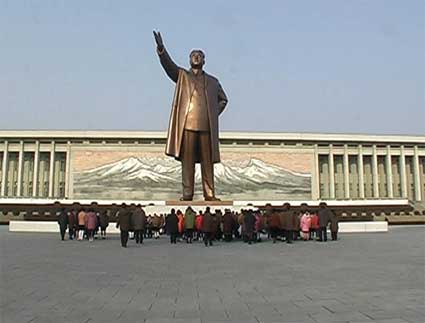 Screenshot from Return to the Border by Zhao Liang, 2005
Screenshot from Return to the Border by Zhao Liang, 2005
Equally moving is Return To The Border, a documentary in which Zhao Liang narrates the return to his hometown, Dandong, near the border with North Korea. Until the 1990s, these two socialist states were allies. However, the minute China concluded a trade treaty with South Korea, trade and cooperation was terminated and the people were forcibly plunged into opposite camps. Traveling along the river that separates the two countries, the filmmaker examines what is left of the socialist dreams on both sides of the water.
Video extract:
In his section, Davide Quadrio, director of BizArt Art Centre in Shanghai, developed a very engrossing multi-screen installation entitled 40 + 4 Art is not enough, not enough! Working together with documentary filmmaker Lothar Spree and filmmaker Zhu Xiawen, he interviewed forty different artists in Shanghai and asked them a series of questions about the role of the artist, their relationship with the external world, the social consequences of their work and the international market effects on traditional artistic production modes. The video, edited from 90 hours of film, offers a portrait as much as a dynamic investigation into the fast changing landscape of Shanghai’s art scene. On another level, the film stretches beyond the limits of Shanghai and offers a study of the contemporary art scene in China that reveals what lays beneath the glossy, enchanting and almost uniform surface Westerners are used to see in exhibitions.
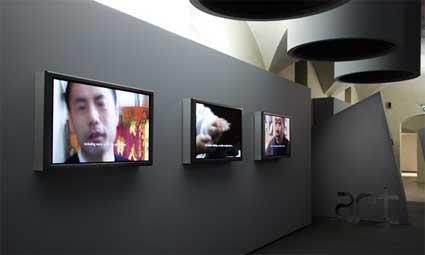
The third curator, Zhang Wei, is the director of Vitamin Creative Space Contemporary Art in Ghuangzhou. With Throwing Dice, she composed a mosaique of individual visions of human existence in a constantly changing world. The videos of Kan Xuan, Pak Sheung Chuen and Yang Fudong, Cao Fei’s explorations into Second Life, technological installations by Chu Yun, and paintings by Duan Jianyu offer individual stories that engage the spectator in the discovery of the artistic sensibility in China today.
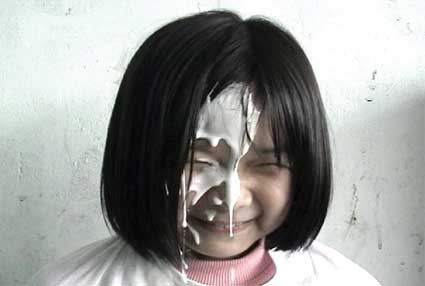 Tseng Yu-Chin, Who is listening (screenshot)
Tseng Yu-Chin, Who is listening (screenshot)
China China China!!!, Chinese contemporary art beyond the global market is on view at the Centre for Contemporary Culture Strozzina (CCCS), part of the Fondazione Palazzo Strozzi in Florence, until May 4, 2008.
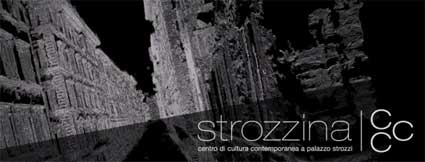
Another date to add in your agenda:
On May 15, Exploded Views – Remapping Florence, a specially-commissioned new installation by Dutch media artist Marnix van Nijs, will premiere at the CCCS.



